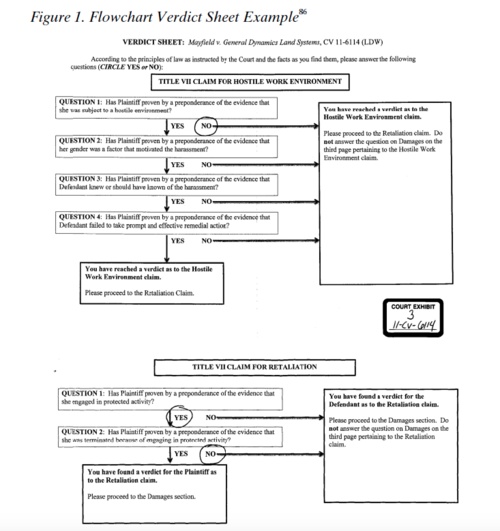By Dr. Ken Broda Bahm:
Juror C: Okay, we’ve answered question four, so let’s move on to five.
Juror A: No, it says that if we answered “No” to four, then we skip to seven…
Juror D: …I totally know the answer to six, it is “Yes!”
Juror A: Wait, wait, we should not even be answering that…
Juror D: Well, let’s just see what everyone thinks…
Juror F: Yeah, just to be on the safe side, let’s answer each one, and we can always cross it out later.
Juror A: No!
That is a small sample of the kinds of confusion one can see when a jury confronts a complex verdict form. In the mock trial observation room, counsel and clients might be tearing their hair out over mistakes that could risk an inconsistent or ambiguous verdict in the actual trial. Lawyers and judges will strive mightily to clarify the verdict form and make sure it has clear skip instructions, but it is easy to see that most verdict forms, particularly special verdict forms in complex trials, sow barriers in the way of a clear or simple verdict.
A recent article in the Duke Law Journal proposes an intriguing possibility for a better way. To address the hazards of verdict inconsistency — damages without predicate liability or cause, or duplicate damages for the same harm awarded in more than one category, for example — the article (Fang, 2014) makes a compelling argument for flowchart verdict sheets “as a prophylactic against juror confusion.” Inconsistent verdicts are burdensome and expensive, sometimes requiring a do-over in whole or in part. “By mitigating the confusion that can result in inconsistencies before the verdict is rendered,” Jerry Fang writes, “the flowchart verdict sheet enables the judicial system to avoid the costs associated with remedying inconsistent verdicts.” This post takes a look at this interesting legal reform idea and shares some thoughts on how it might be incorporated in civil trials.
The idea is to use simple visual communication techniques to make the verdict process more clear and intuitive. The author shares an example of a flowchart verdict sheet created for an employment discrimination case in the Eastern District of New York:
(Please click to see full-sized version)
Comparing the chart above to a traditional verdict form, it is clear that the flowchart version gives jurors an immediate visual sense of their decision making path, a sense that a careful jury would only possibly get after specifically reading the text of a more conventional verdict form.
Consider Using a Flowchart Verdict Form
The article recommends the creation of model flowchart verdict forms by the federal judiciary. but that should not prevent parties from individually or jointly proposing this design. Flowchart verdict forms are not yet in common use, but that won’t change unless litigators ask for it and judges try it. All (usually) have an interest in clarity, and as Jerry Fang writes, “These ‘flowchart verdict sheets’ can visually — and in a clear and intuitive manner — ‘map’ the cognitive decisions a jury must make to reach a verdict.” They realistically mirror how jurors are following a process and choosing a path. For support, Fang points to a study (Semmler & Brewer, 2002) showing that representing instructions in flowchart fashion did lead to improved comprehension of the instructions, including better retention and recall as well.
But Consider How It Looks As Well
A flowchart is visually quite different from the typical linear presentation of verdict questions. Because that difference could have an effect on how jurors interact with the questions, parties will need to think carefully about how the chart is laid out. For example, it will be important for the visual space to be about equal on the “Yes” and “No” sides. One side shouldn’t look simpler, easier, or more ‘downhill’ than the other. In the article, Jerry Fang draws on Edward Tufte, the Yale University professor most famous for his war against PowerPoint, and shares a few reminders that should go into the design. Litigators interested in trying this approach would be well advised to have any proposed flowchart verdict form designed, or at least reviewed, by a graphic designer for clarity, simplicity and fairness.
Even Without a Flowchart Verdict Form, You Can Still Explain the Verdict Process Using a Flowchart
Even if the judge is likely to err on the conservative side and veto any near-term use of a flowchart verdict form, that does not prevent you from using a flowchart as an educational tool. If the jury understands the process visually, they can apply that understanding to a linear and traditional verdict form that uses skip instructions. So consider using slides in closing argument that lay out the decision making sequence in the most understandable fashion, which is probably a flowchart. In a mock trial, you might also think about using a flowchart verdict form as a shortcut. For example, you might think you’ll have a chance to really explain a complex traditional verdict form in the real trial, but you don’t want to sacrifice the time that it would take to do so in a mock trial, so you rely on the more visually obvious version for expedience.
The idea is pretty new, so some caution is warranted. The Fang article makes the valid point that much comprehension studies have focused on whether jurors understand the instructions, not whether they understand the form itself. So a quick message to academics who want to publish and not perish: An interesting study design would be to compare two versions of the same verdict form — one framed in the traditional style and the other in a flowchart style — and see if there are differences in comprehension, speed, and overall result.
______
Other Posts on Verdicts and Instructions:
- Close Your Case By Walking Through the Decision and Verdict Form (Another Note on the John Edwards Trial)
- Take a Schematic Approach to Jury Instructions
- Get the Gist of How Jurors Decide Damage Numbers
______
Fang, J. J. (2014). 12 Confused Men: Using Flowchart Verdict Sheets To Mitigate Inconsistent Civil Verdicts. Duke Law Journal, 64(2), 287-331.
Semmler, C., & Brewer, N. (2002). Using a flow-chart to improve comprehension of jury instructions. Psychiatry, psychology and law, 9(2), 262-270.
Image Request: 123rf.com, used under license

